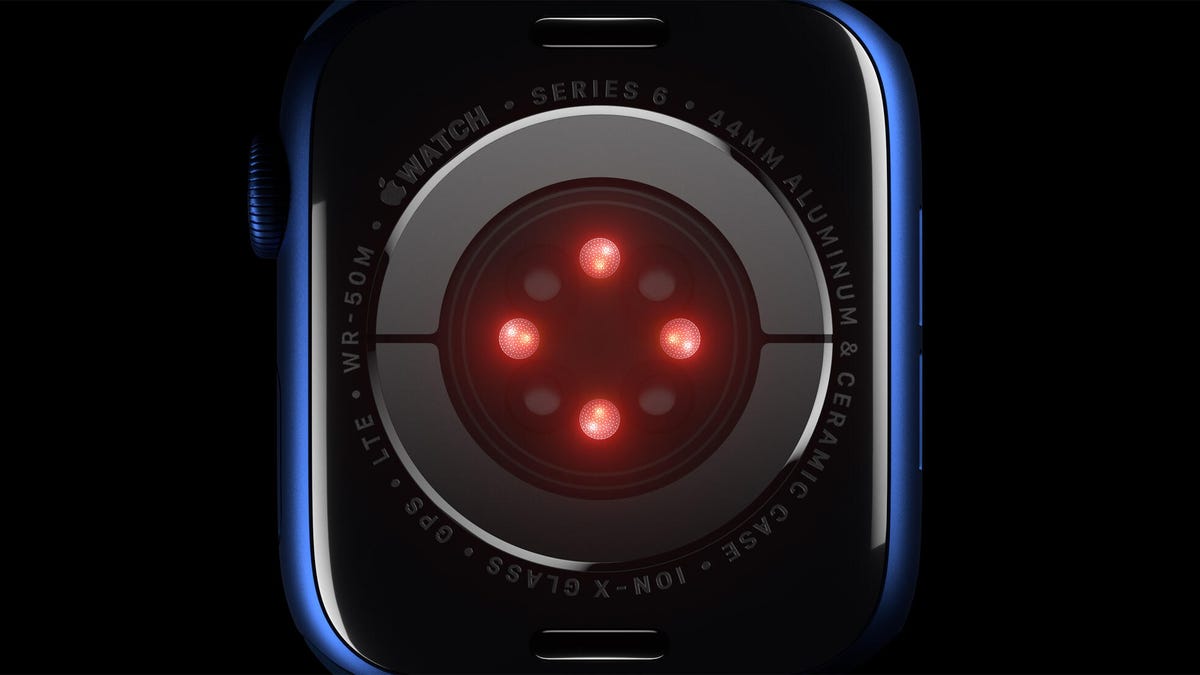What are blood oxygen levels? The lesser-known important health metric
The new Apple Watch comes with a blood oxygen sensor; here's what it can and can't tell you.

Apple Watch Series 6 includes a blood oxygen level (SpO2) sensor.
Blood oxygen levels have come into the spotlight this year because health practitioners are using that metric to check for and monitor COVID-19 cases. But blood oxygen, or SpO2, levels have been used long before COVID-19 as an important indicator for your heart, lung and overall health. Simply put, your blood oxygen level (or SpO2 level) is the amount of oxygen in your blood. This health metric, which is often called the fifth vital sign, is important to monitor in people who have respiratory conditions, COVID-19 included.
Unlike your heart rate, which you can feel if it gets too high, it's not easy to self diagnose low blood oxygen levels, also called hypoxemia. You might have shortness of breath, but you could also look and feel totally fine. While there have been many people with COVID-19 who experience hypoxemia, many other reasons, including health conditions or environmental factors, can also cause hypoxemia.
Traditionally, to measure SpO2 you need a pulse oximeter (a device that clips on your finger). But with the new Apple Watch Series 6, you can now monitor blood oxygen with the watch's new blood oxygen sensor and app. Keep reading to learn more about how blood oxygen levels work, what they mean and why Apple is including it as a new feature in its latest watch.
What are blood oxygen levels and how are they measured?
Blood oxygen levels can tell you how well your body can absorb and use the oxygen you breathe in, which is transported to your red blood cells through your lungs. In order to be considered healthy, you need at least a 90% blood oxygen saturation level reading from a pulse oximeter, according to the Mayo Clinic.
All of the cells in the body need oxygen to function properly, so low blood oxygen levels can indicate or precede a health problem. Keep in mind that low oxygen levels don't always indicate a medical condition, and they can be reversed with proper treatment. But, if oxygen levels remain low or continue to decline, it's important to seek medical intervention. If you have hypoxemia, especially if your levels are very low, you can have serious health complications in your organs or other body tissues.
People have been purchasing more pulse oximeters in the wake of COVID-19 since doctors found that some COVID-19 patients were being admitted to hospitals with very low blood oxygen levels. That's not surprising, as one of the common symptoms of COVID-19 is shortness of breath, which can affect your body's ability to get and use enough oxygen.
Low blood oxygen levels can't tell you if you have COVID-19, but if your blood oxygen levels begin to decline, you will want to seek medical attention or testing. If you have been diagnosed with COVID-19, monitoring your blood oxygen levels is something that your health care provider may suggest you do at home so they can know if your condition is improving or getting worse.
Many health conditions (other than COVID-19) can cause low blood oxygen levels including:
- Asthma
- Heart disease
- Lung disease
- Chronic obstructive pulmonary disease or COPD
- Pneumonia
- Fluid in the lungs
- Sleep apnea
Monitoring your blood oxygen levels could help detect these medical problems, or help you manage them if you are diagnosed.
Why does the Apple Watch have a blood oxygen sensor?
Apple's new blood oxygen level (SpO2) sensor and app is timely in the wake of the COVID-19 pandemic and as the popularity of pulse oximeters sky rocketed over the summer of 2020. At this time, Apple isn't making any kind of claims of how the blood oxygen readings from the Apple Watch can affect your health, but the company is launching several studies to explore it.
Apple Watch Series 6 shows your blood oxygen level on the screen.
The tech giant is teaming up with University of California, Irvine and Anthem to see how long-term blood oxygen monitoring could help patients with asthma. Apple is also working with the Ted Rogers Centre for Heart Research and the Peter Munk Cardiac Centre at the University Health Network to examine how blood oxygen measurements and other health metrics the Apple Watch records can help with managing heart failure.
Finally, it's teaming up with the Seattle Flu Study at the Brotman Baty Institute for Precision Medicine and the University of Washington School of Medicine to explore if heart rate and blood oxygen measurements from the Apple Watch could give you early warning signs of respiratory conditions, such as influenza and COVID-19.
It will likely be years until we get concrete results from those studies, but Apple is planting the seed but adding a blood oxygen sensor to the Apple Watch. That will ultimately help gather information from thousands of people, for (hopefully) more conclusive answers of how monitoring your blood oxygen can make you healthier.

